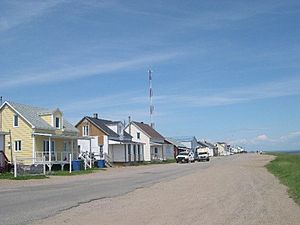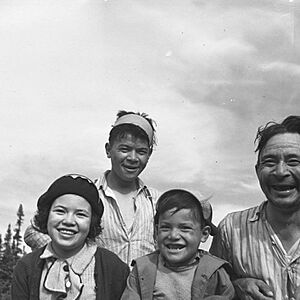Pessamit Innu Band facts for kids
The Pessamit Innu Band (officially called bande des Innus de Pessamit) is a group of Innu First Nations people in Quebec, Canada. They are like a self-governing community. Most of their members live on the Indian reserve called Pessamit. This reserve is located in a region called the Côte-Nord, which is on the north side of the Saint Lawrence River.
In 2017, about 3,953 people were officially registered as members of the Pessamit Innu Band. This community is led by a group called the Conseil des Innus de Pessamit. They also work with the Mamuitun Tribal Council. In the past, this band was known by other names, like Bersimis and Betsiamites.
Contents
Where the Pessamit Innu Live
The Pessamit Innu Band has one special area of land called an Indian reserve. This reserve is named Pessamit. It used to be known as "Betsiamites." Most of the band members live here.
The reserve is located in the Côte-Nord region of Quebec. This area is on the north shore of the Saint Lawrence River. It's about 40 kilometers (25 miles) southeast of a town called Baie-Comeau. The Pessamit reserve covers a large area, about 25,242 hectares (62,374 acres). Baie-Comeau is the closest town for services, and the biggest city nearby is Quebec City.
A Look Back: Pessamit Innu History
The ancestors of the Innu people have lived on the north shore of the Saint Lawrence River for a very long time. They have been there since at least 5500 B.C.
Early Encounters and Missions
In 1534, a European explorer named Jacques Cartier met a group of people near Tadoussac. He called them "Papinachois." These were actually the ancestors of the Innu. Later, French settlers called them "Montagnais."
From 1632 to 1782, many Jesuit missionaries came to teach the Innu about Christianity. In 1849, the Innu people of Pessamit built a chapel where their village is today.
Creating the Pessamit Reserve
In 1851, a Catholic priest named Father Arnaud asked the Government of Canada for land. He wanted to set aside about 70,000 acres for the Indigenous peoples. This land was west of the Rivière aux Outardes. The government agreed the next year.
The Indian reserve of Pessamit was officially created in 1862. At that time, the band was known as "Bersimis."
Education and Name Changes
In 1901, a group of nuns called the Sœurs du Bon-Conseil came from Chicoutimi. They started providing education on the reserve. Later, in 1979, the Conseil des Innus de Pessamit took over the responsibility for education.
The band changed its name in 1981 to "Betsiamites." Then, in 2001, they changed it again to their current name, "Pessamit."
Pessamit Innu Population
The people who are members of the First Nation of Pessamit are Innu. In March 2017, the band had a total of 3,953 registered members. Out of these, 1,022 lived outside the reserve.
According to Statistics Canada's 2011 Census, the average age of the people in Pessamit was 29.3 years old.
Here are the numbers for registered band members as of May 2024:
- Total members: 4,185
- On Betsiamites Reserve: 2849
- On other reserves: 74
- Off reserve: 1259
Religion in Pessamit
Most of the Innu people in Pessamit are Catholic. The main church in Pessamit honors Our Lady of Assumption. The older members of the community are very devoted to her.
Traditionally, the Innu of Pessamit would leave for their hunting grounds on August 15. This day is the Feast of Our Lady of Assumption.
Languages Spoken in Pessamit
The language of the Innu people is called Innu-aimun. It is an Algonquian language.
According to Statistics Canada's 2011 Census from 2011, out of 2,420 people, 2,350 knew an Aboriginal language. This means 97% of the band population knew an Indigenous language. About 95.5% of the people still spoke and understood an Aboriginal language as their first language. Also, 96.7% spoke an Aboriginal language at home.
Older people, those 65 and above, still speak the traditional language well. However, for people aged 40 to 65, some words about traditional activities and the forest are being forgotten. Among people under 40, knowledge of the language is decreasing with each new generation. Many French words are now used even in conversations in Innu-aimun.
Regarding official languages, 18% of the people know both French and English. About 76% know only French, and 6% do not know either official language.



